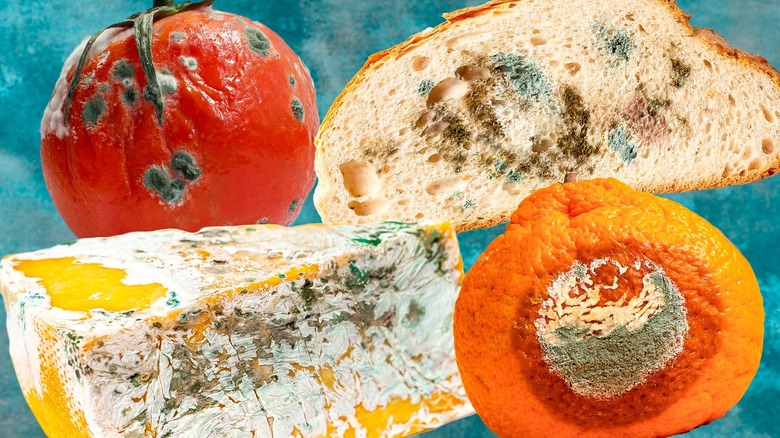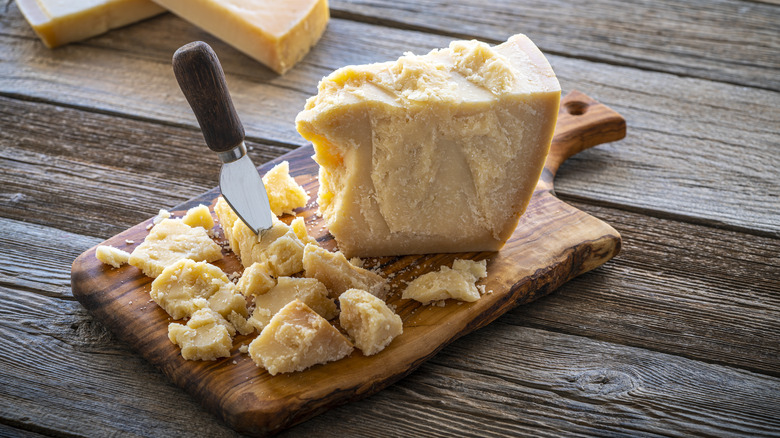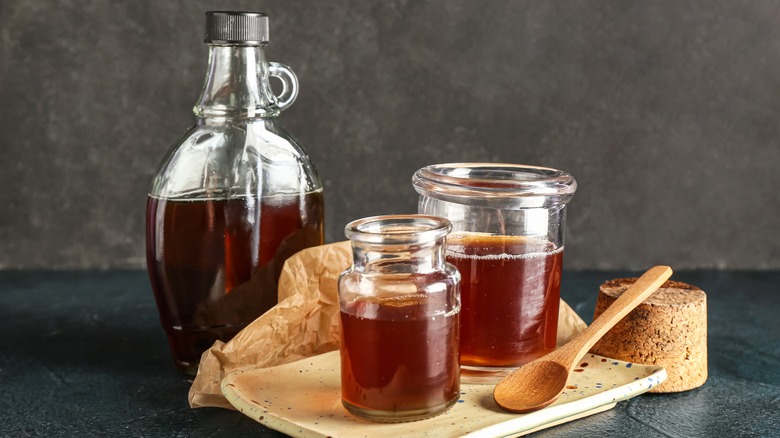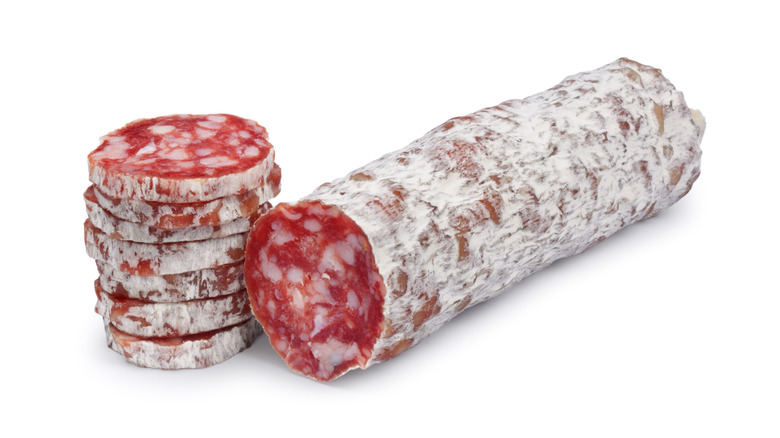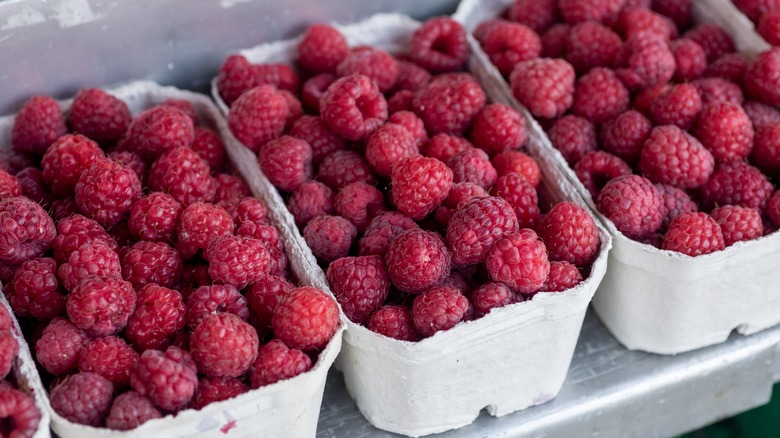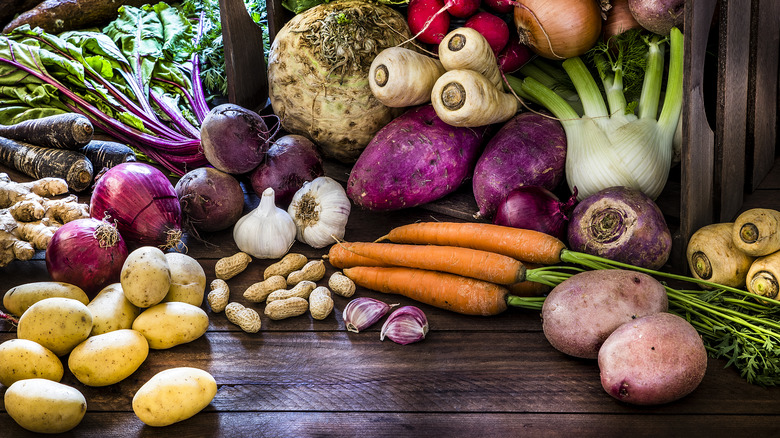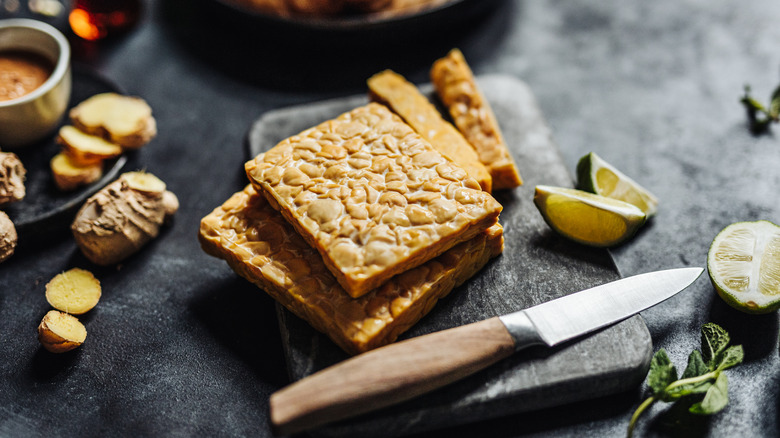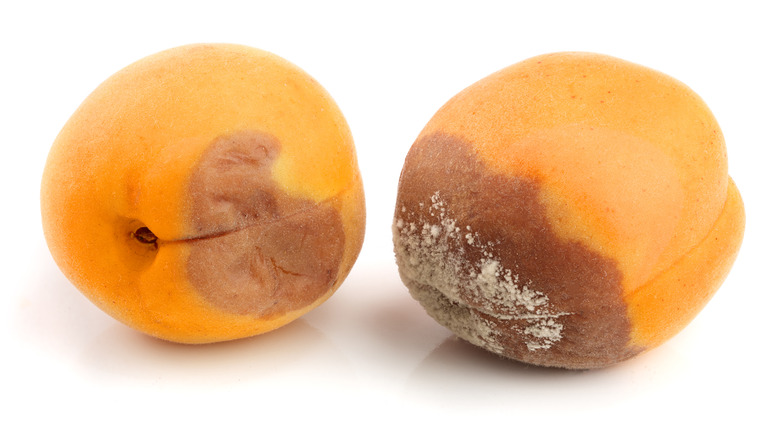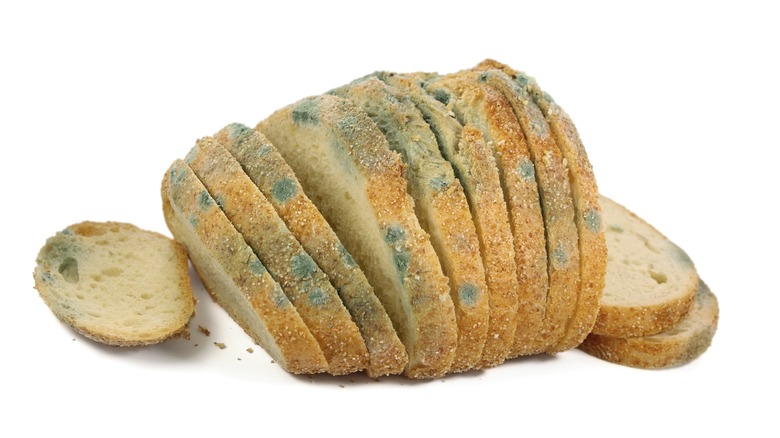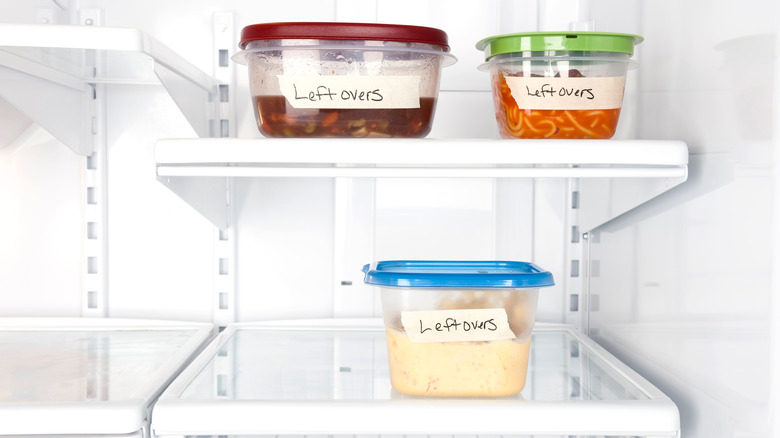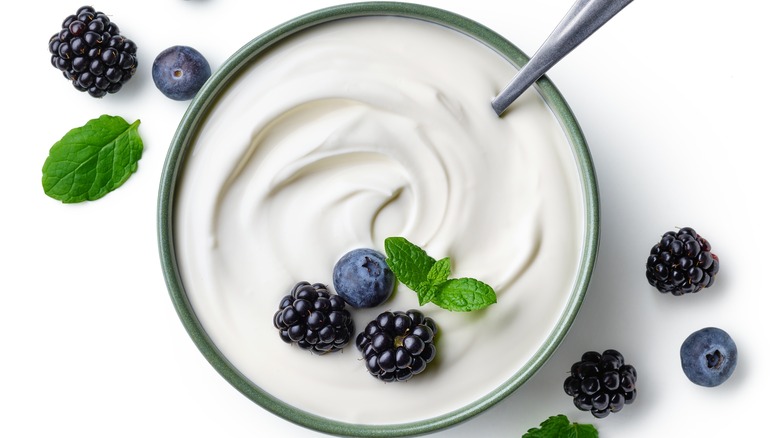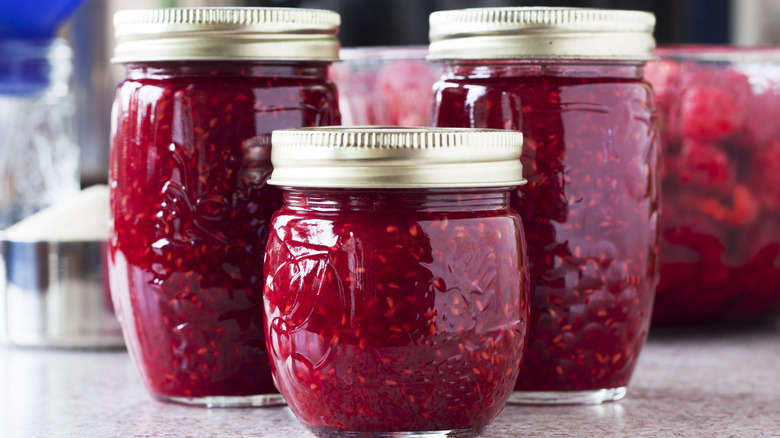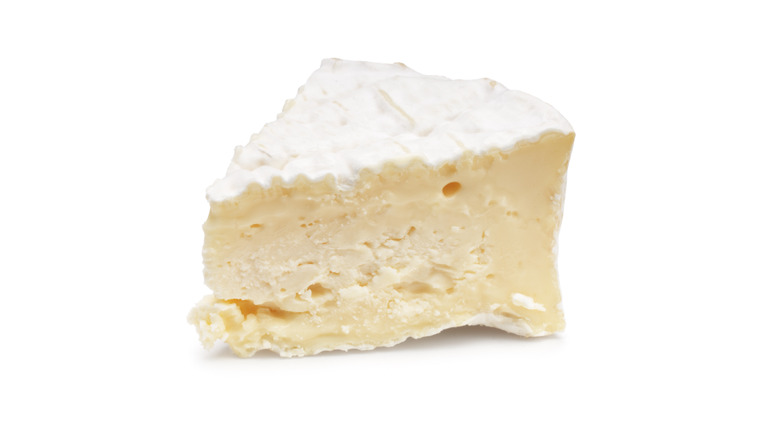12 Foods You Can (And Can't) Salvage Once They Grow Mold
There's something unsettling about seeing mold where it shouldn't be. You go to the fridge to heat some leftovers and toast a slice of bread, and a big fuzzy spot is staring back at you from what you thought was going to be your next meal. While mold can produce toxins that are potentially hazardous to your health, not all moldy food needs to be thrown away.
Food waste is a massive problem in the United States, with 119 billion pounds of food wasted each year, which amounts to a whopping 40 percent of all food that ends up in the trash can. In fact, the food waste management industry is set to boom because the staggering amount of food isn't just bad for the environment; it's bad for business.
One way to cut down on your own food waste is to educate yourself on which foods actually need to be thrown away and which foods can be salvaged so that they can still be consumed. Read on to find out how mold affects different types of food so that you can make the most out of everything in your refrigerator.
Can: hard cheeses
Moldy cheese isn't what you want to encounter when you're about to whip up something like potatoes au gratin with gruyere or sprinkle some parmigiano reggiano on a hot plate of spaghetti marinara, but it's not exactly an uncommon sight in the fridge. But don't toss that cheese just yet. Parmesan, Pecorino Romano, aged cheddar, Grana Padano, gruyere, and any other hard cheese can be salvaged by simply cutting about an inch around the mold and using the remainder. These cheeses are dense and have a low moisture content, which means the mold doesn't penetrate very far into the cheese, leaving the rest safe for consumption.
To make sure your hard cheeses last as long as possible, store them in the refrigerator and don't wrap them in plastic wrap. Although this is standard practice in grocery stores, it's not a great method long-term because the plastic traps moisture, which can encourage the growth of mold. Instead, use a container with a vent or, if you don't have one, put the cheese in a container with a lid and leave one of the corners a bit open so that you and your cheese can both breathe easily.
Can: maple syrup
While maple syrup might not be the first item that pops into your head when you think of moldy food, if you leave it out for too long, you'll see that the sweet, golden liquid destined to douse your pancakes can grow little spots of mold. And maple syrup isn't just a delicious, natural way to satisfy your sweet tooth without refined sugar; it's also expensive, which makes it that much more difficult to part with a bottle that's gone bad. But luckily, you don't need to.
There's a simple way to save maple syrup from the garbage if you find mold floating on its surface. After removing the moldy part of the maple syrup floating on top of the liquid, use a saucepan to boil the rest of it for a few minutes between 180 F and 190 F to make sure any remaining mold has been killed off. Since the mold that grows on maple syrup is non-toxic and only grows on the surface, the remainder of the maple syrup is fine to consume after it's been boiled. To keep your maple syrup fresh as long as possible, store it in the refrigerator in an air-tight container after you open it.
Can: cured meats
You may not know this, but if you're preparing a charcuterie board, chances are it already has mold. If you've ever bought artisanal cured meat, you may have noticed a white fuzz that coats its outside layer. This, my friends, is mold. Not only do most artisanal cured meats have mold on the outside, but some believe that the whiter the mold on the outside, the better quality cured meat you're about to enjoy.
But you can't eat just any mold growing on your cured meats. The white mold on your salami actually protects it from a different kind of fungus that is green or black in appearance, and those are the ones to avoid. If you find black mold on your cured meat, throw it away immediately. If you find green mold in its early stages, however, the meat can still be salvaged by dipping a cloth in vinegar and wiping down the meat, which will act as a disinfectant. If the green mold has progressed further, it will be brighter in color, hairy instead of crumbly, and smell different than the white mold, which is also a sign that your cured meat is beyond cure and should be tossed.
Can: a carton of berries
Berries are a perfect sweet treat. As most berry lovers know, however, these soft, sweet, juicy morsels are delicate and prone to mold (not to mention pricey). But does one bad berry ruin the bunch? People often wonder what to do with a carton of berries when one or two are moldy, and luckily, in most cases, the rest of the carton of berries is still salvageable.
While you should certainly throw away the berries that are obviously affected by mold, you can use your judgement when it comes to the rest. Although there's probably little harm done if you accidentally eat a moldy berry by accident (the mold that lives on berries is not toxic in small amounts), it's not exactly a pleasant experience. Generally, if the other berries are still firm and not oozing, they're fine to eat. But mold spores spread rapidly, so after you discard the moldy berries, try to eat the rest quickly. Berries have thin skin and are easily colonized by fungal spores which can live in your fridge, so if you're a die-hard berry enthusiast, you should wipe down the inside of your fridge with a solution of water and baking soda to remove any spores that might be in there.
Can: hard vegetables
Mold spreads through spores in the air and once a food is affected, the mold spreads with filaments that penetrate into the food and continue to feed the mold. When it comes to foods like cabbages, bell peppers, potatoes, carrots, and other hard vegetables, mold has a difficult time penetrating deep into the food because it is so dense. This means that if the mold has not spread to cover the entire vegetables, it's safe to eat some moldy carrots and other hard vegetables provided you cut about an inch off around the affected area and discard it.
To keep your vegetables fresher longer and prevent them from getting moldy in the first place, it's best to know how to store them correctly. Carrots should be put in a plastic bag with a damp paper towel in the refrigerator, potatoes can be left out if the ambient temperature is less than 50 F, and bell peppers can be cut up and put into plastic bags and stored in the freezer. Make sure not to store your vegetables close to fruits, which will cause them to go bad more quickly.
Can: tempeh
Tempeh is a newcomer to mainstream American grocery stores, and since this traditionally Indonesian soy product comes fermented already, it's often mistaken for rotten when it's perfectly fine. After your tempeh has been sitting in the fridge for a while, you may pull it out expecting it to be the light tan color it was when you bought it, only to find that it's covered in dark gray and black spots. Although this might not sound appetizing, it's a perfectly normal part of the aging process of the fungus used to make the tempeh. It's also normal for tempeh to smell a bit fungal (like mushrooms).
So how do you know when your tempeh's gone bad? Tempeh should be firm, and a dead giveaway that your tempeh is beyond repair is that it becomes mushy, crumbly, and difficult to cut into clean slices. Also, pay attention to the color and the smell; if your tempeh has green mold on it or it smells strongly of alcohol or ammonia, then you know to get rid of it. But don't fret! This protein-packed superfood is relatively inexpensive, with a block setting you back only about 4 or 5 dollars.
Can: hard fruits
Fruits like strawberries, peaches, and tomatoes are perfect summer treats. They're plump, juicy, and have a high water content, which also makes them perfect breeding grounds for dangerous molds. When mold grows on a fruit that is very moist and juicy, it's easy for the mold to grow filaments that penetrate deep into it. Hard fruits, on the other hand, are denser and less likely to have mold growing deep inside. If there's just a bit of mold on the outside of a piece of hard fruit, it's fine to cut the bad part out, wash the rest of the fruit, and go ahead and eat it, but be sure to only wash it right before you consume it because the extra water can make it spoil more quickly. If the whole fruit has gone soft, however, it's best to throw it out, as this may indicate that the mold has spread throughout it.
To make your fruit last as long as possible, it's best to store it in its original packaging inside the crisper drawer of the fridge. Fruit packaging typically has holes that allow the fruit to breathe, which keeps it fresher longer. If you do accidentally eat a bit of moldy fruit, it's typically not dangerous unless you're elderly, immunocompromised, or allergic to mold.
Can't: bread
Nothing says breakfast like a nice piece of toast, but if you notice any mold on your bread, it should go straight into the trash can. Several different types of mold can grow on bread, and they can be harmful to your health. Although you may think it's fine to discard just the offending slices and keep the rest of the loaf, you'd be mistaken. Because bread is so porous, it's very easy for mold to spread quickly throughout the loaf and remain invisible to the naked eye. And don't sniff moldy bread either. Mold spores spread through the air, and they can contribute to health issues like asthma.
To keep bread longer, the best option is to slice it, wrap it in plastic or tin foil, freeze it to inhibit mold growth and keep the bread tasting fresher when you reheat it. While keeping bread in the refrigerator will dramatically lengthen the time it takes to turn moldy, it dries out the bread, giving it a stale taste.
Can't: leftovers
There is a huge variety of molds that grow on food. While the mold that makes gorgonzola cheese tangy is perfectly healthy to eat, the mold that grows on most leftovers, especially pasta, grains, and casseroles, is known to produce mycotoxins, which are toxic substances produced by fungi. Leftovers comprise a huge category of different types of food, so the studies that have been conducted on the safety of moldy leftovers are limited compared to other types of foods.
Mycotoxins are also heat resistant, so they won't die off when you reheat your leftovers. Most leftovers also have a relatively high water content, which makes them more prone to mold penetrating below the surface. You should only keep them for about three or four days and don't reheat frozen leftovers more than once, not only because the quality of the taste diminishes but also because it poses a greater risk to your health. So when it comes to leftovers, you should go by the old adage: "When in doubt, throw it out."
Can't: yogurt
Yogurt is a great source of protein and healthy bacteria that can keep your digestive tract healthy and functioning well, but if you see mold in your yogurt container, you don't want to eat it. If there's just a bit of mold on the top, you may be tempted to just scrape it off and eat the rest, but doing so is a bad idea. Not only does the fungus that grows on yogurt produce enzymes that make it taste bitter and unpleasant, but it can also spread filaments deep into the yogurt that are invisible to the naked eye.
To prevent your yogurt from hosting mold, it's important to store it in an airtight container in the back of your refrigerator rather than in the door, where the fluctuations in temperature can cause the yogurt to spoil more quickly. Although it won't retain its creamy texture, you can put yogurt in the freezer if you're not planning on eating it immediately and thaw it later to make a yogurt cake, which is a great ingredient to make a flourless cake nice and smooth.
Can't: jams and jellies
There's nothing more disappointing than going to make a peanut butter and jelly sandwich and finding that your jam has been contaminated with mold. While it may appear that the mold on jams and jellies just sits on the surface and can be easily scraped off, mold doesn't quite work like that. Jellies and jams have a lot of water, which is an ideal environment for mold to start forming filaments that can penetrate deep into a jar of preserves. While not all molds are dangerous, the mold that grows on preserves is unhealthy for consumption, and you shouldn't try to salvage jam that has mold in it under any circumstances.
To keep the mold from making a home in your sweet preserves, it's important to know how to pack and store them. If you're making jam at home, fill your jar just under the lid of a sterile mason jar and process for at least five minutes in a boiling water canner. Once you open a jam jar, make sure to close it tightly before storing it in the refrigerator so that you can enjoy it for weeks to come.
Can't: soft cheese
Moldy cheese is a complicated topic. As you probably know, mold plays an important role in the cheese-making process and has bestowed humanity with some of the most uniquely tangy, funky, savory flavors on the planet. But there's a difference between the mold that makes blue cheese blue and the mold staining the creamy, white surface of your mozzarella with something that just doesn't look quite right.
When you see mold on soft cheese with a high water content, like cottage cheese, goat cheese, cream cheese, and ricotta, to name a few, you should throw it out. It's not going to kill you if you eat some cheese mold on accident, but this is not the kind of mold that the cheesemaker intended for you to eat, and it will probably be obvious when you taste it why that is. You should keep your soft cheeses in airtight containers in the refrigerator to keep them edible for as long as possible.
